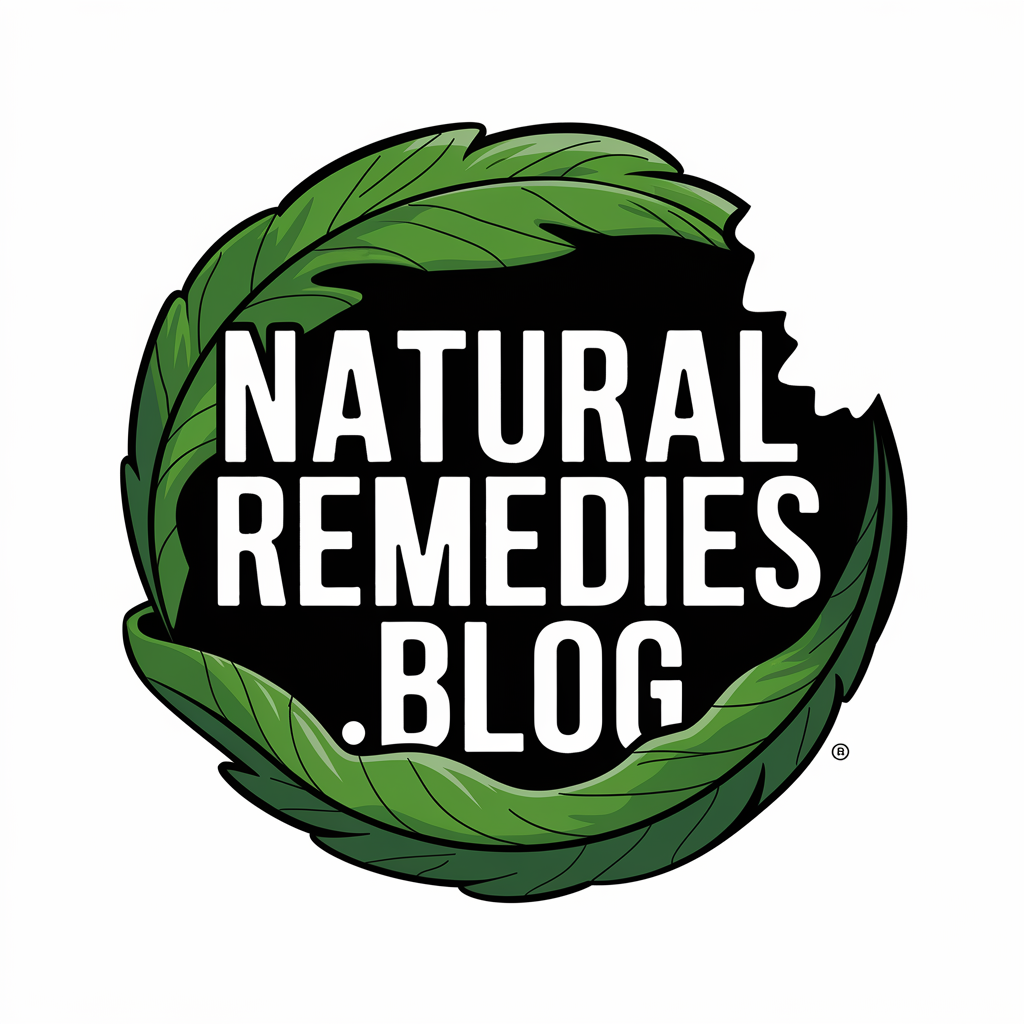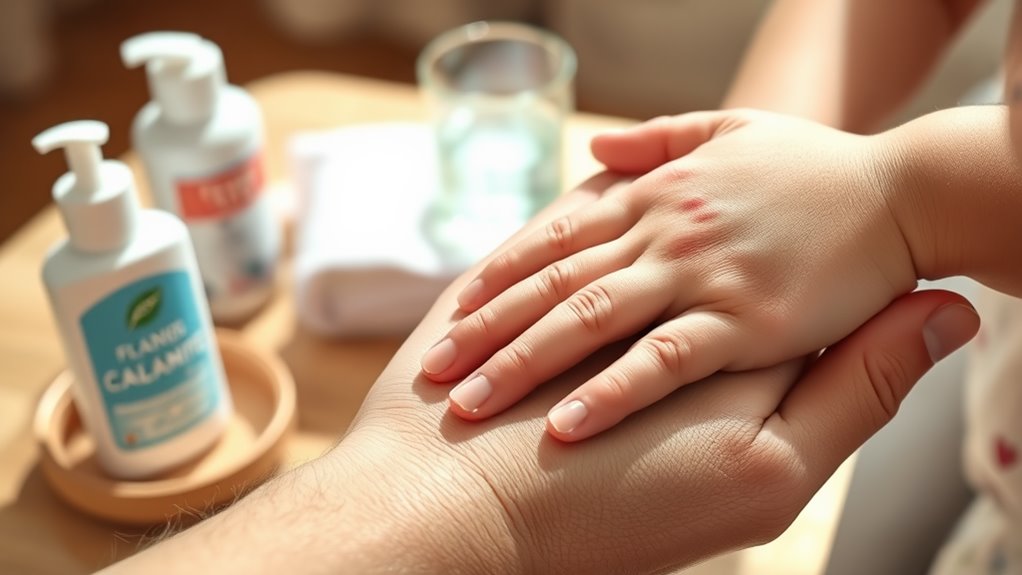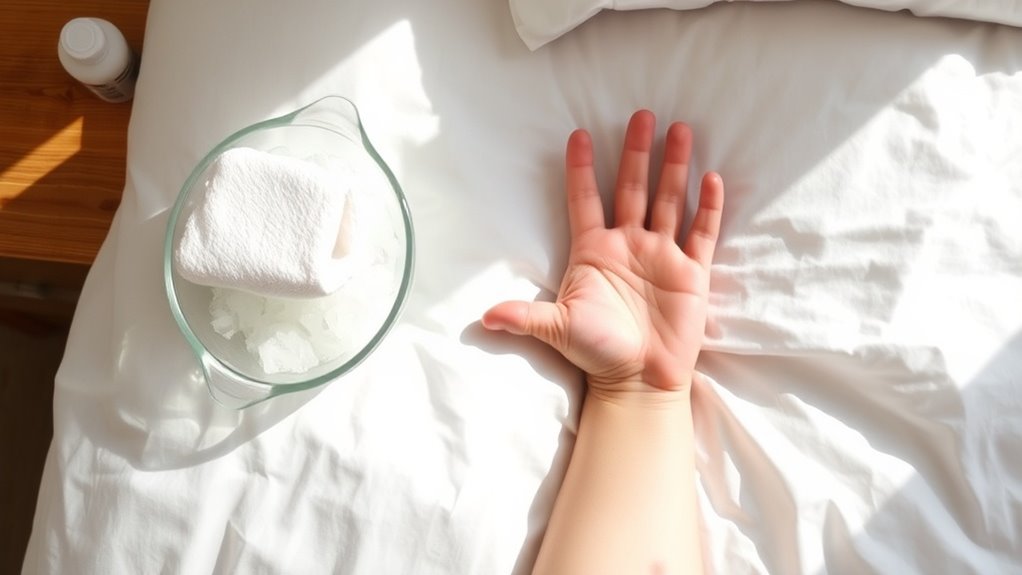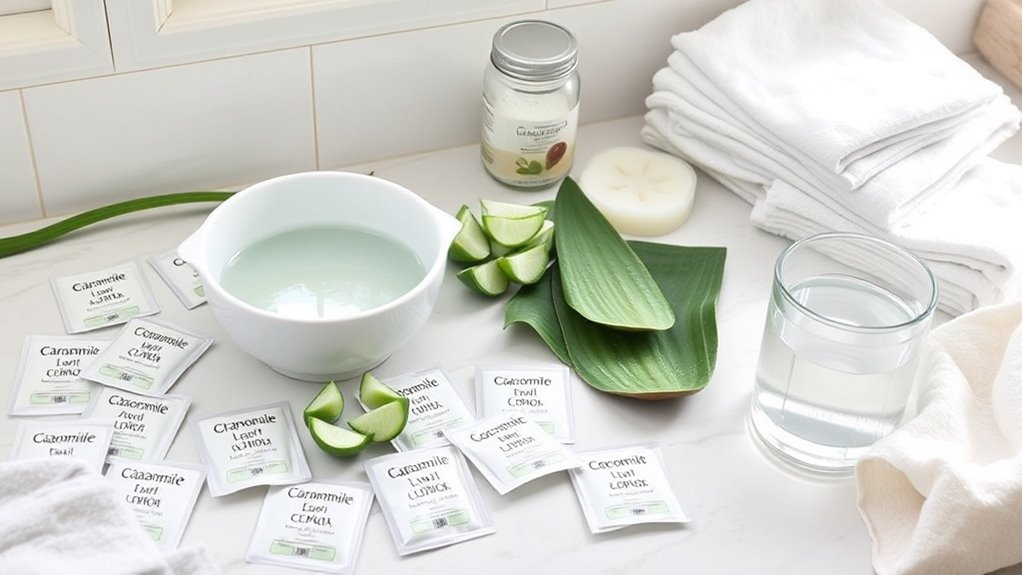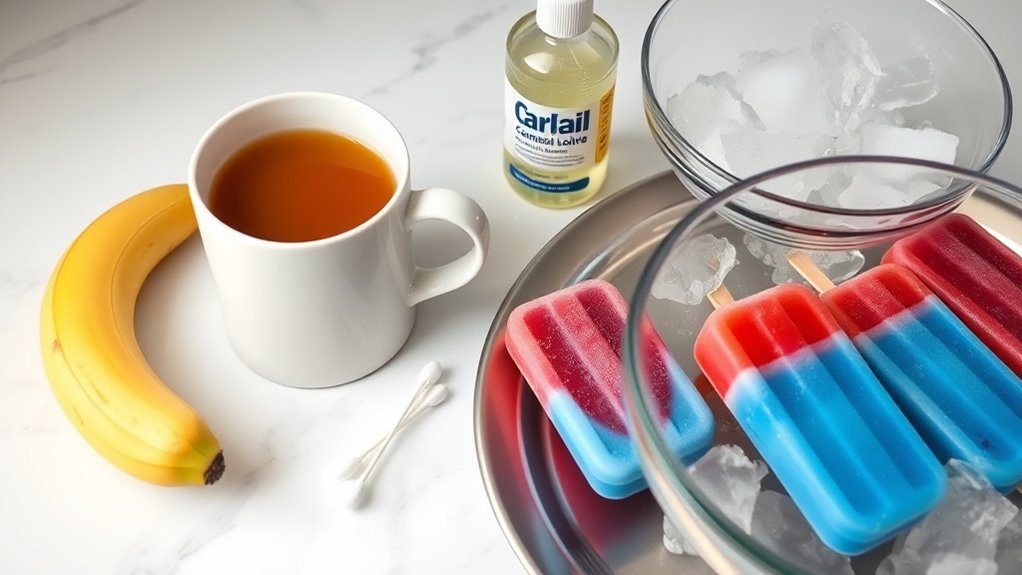A Natural Way to Help With Hand, Foot, and Mouth Disease Symptoms
You can ease your child’s Hand, Foot, and Mouth Disease symptoms with several natural approaches. Offer cold foods like sugar-free popsicles to soothe mouth sores, and apply calamine lotion to uncomfortable rashes. Create a gentle baking soda mouth rinse, and maintain hydration with cool water and electrolyte drinks. Support their immune system with vitamin C-rich foods and adequate rest. These proven remedies represent just the beginning of your natural treatment options.
Understanding Hand, Foot, and Mouth Disease
Hand, foot, and mouth disease (HFMD) is a common childhood viral infection that primarily affects infants and children under the age of five.
You’ll notice the first symptoms typically include fever, sore throat, and reduced appetite. Within days, painful sores develop in your child’s mouth, accompanied by a rash on their hands, feet, and sometimes buttocks.
While you’re searching for hand foot and mouth disease remedies, it’s important to understand that HFMD is caused by enteroviruses, most commonly the coxsackievirus A16. The virus spreads through close contact, respiratory droplets, and contaminated surfaces.
Most cases resolve within 7-10 days without complications.
Common Signs and Symptoms
When your child contracts HFMD, you’ll notice specific symptoms emerging in a predictable pattern.
Initially, your child may develop a mild fever, sore throat, and reduced appetite.
Within 1-2 days, painful sores appear in the mouth and throat, often making it difficult to eat or drink.
A distinctive rash with flat red spots follows, typically appearing on the palms, soles, and sometimes buttocks. These spots may blister and can be itchy or painful.
Your child might become irritable and resist eating due to mouth discomfort.
Most symptoms peak within 3-5 days.
Natural Home Remedies for Relief
Although HFMD must run its natural course, several home remedies can help ease your child’s discomfort and support healing.
Offer cold foods like sugar-free popsicles or ice cream to soothe mouth sores. Create a baking soda mouth rinse by mixing 1/2 teaspoon in warm water.
Apply calamine lotion to itchy rashes, and use coconut oil to moisturize affected skin areas. Encourage hydration with cool water and electrolyte drinks.
For fever management, try lukewarm baths. Essential oils like lavender or chamomile, when properly diluted, can help calm irritated skin.
Keep your child’s fingernails trimmed to prevent scratching and infection.
Essential Oils and Their Benefits
While treating your child’s symptoms of hand, foot, and mouth disease, you’ll find several essential oils that can provide natural relief, including lavender, chamomile, and tea tree oil.
You’ll need to dilute these oils properly with a carrier oil and apply them only to unbroken skin areas for safe, effective use.
These gentle oils can help reduce discomfort through their anti-inflammatory and soothing properties, making them valuable additions to your natural treatment approach.
For best results, combine essential oil applications with cold fluid intake to help manage pain and maintain proper hydration levels.
Safe Essential Oil Choices
Since essential oils offer natural antimicrobial properties, several options can help soothe your child’s symptoms during hand, foot, and mouth disease. When selecting essential oils, always choose therapeutic-grade products from reputable manufacturers.
| Safe Oil Choice | Best Used For |
|---|---|
| Lavender | Skin soothing, sleep |
| Tea Tree | Antiviral support |
| Chamomile | Calming, rash relief |
| Eucalyptus | Respiratory comfort |
| Thyme | Immune support |
Remember to dilute these oils properly with a carrier oil like coconut or jojoba. For children under 2, consult your pediatrician before use. Always perform a patch test first to ensure there’s no skin sensitivity.
Proper Application Methods
The safe application of essential oils requires careful attention to proper dilution and method of use.
For children with hand, foot, and mouth disease, you’ll need to dilute essential oils with a carrier oil at a 0.5-1% ratio. That’s 3-6 drops per ounce of carrier oil.
Apply the diluted mixture to your child’s feet, back, or chest – avoiding face, hands, and affected areas.
You can also add 2-3 drops to a diffuser for aromatherapy benefits.
Don’t apply oils directly to blisters or sores, and stop use if any irritation occurs.
Natural Soothing Properties
Several essential oils possess natural compounds that can help soothe discomfort associated with hand, foot, and mouth disease in children. These oils provide relief through their anti-inflammatory and antimicrobial properties when properly diluted.
| Oil Type | Benefits |
|---|---|
| Lavender | Calms skin, reduces inflammation |
| Tea Tree | Fights bacteria, eases itching |
| Chamomile | Soothes rashes, promotes healing |
You’ll need to mix these oils with a carrier oil like coconut or jojoba before applying them to your child’s skin. Remember to perform a patch test first to check for sensitivity, and never apply essential oils directly to open sores or mucous membranes.
Dietary Recommendations During Recovery
Making dietary adjustments during hand, foot, and mouth disease recovery helps reduce discomfort and speeds healing, particularly when mouth sores make eating difficult.
Choose cool, soft foods like yogurt, smoothies, and ice cream that won’t irritate mouth sores.
You’ll want to avoid acidic foods such as citrus fruits, tomatoes, and spicy dishes that can cause burning sensations.
Ensure your child stays hydrated by offering frequent sips of cold water or electrolyte solutions through a straw.
If your child’s reluctant to eat, try freezing favorite beverages into popsicles.
Cold milk, protein shakes, and nutrient-rich purees can provide essential nutrition while minimizing pain.
Chamomile tea applied directly to mouth sores can provide natural pain relief and antiviral benefits.
Herbal Solutions for Skin Lesions
Natural herbs can help soothe skin lesions and blisters associated with hand, foot, and mouth disease. You can apply chamomile tea compresses to affected areas, as they contain anti-inflammatory properties that reduce discomfort.
Aloe vera gel offers cooling relief and promotes healing, while calendula ointment helps prevent secondary infections.
For your child’s comfort, try diluted lavender essential oil in a carrier oil, or create a gentle witch hazel solution.
Licorice root extract, when applied topically, can reduce pain and inflammation. Remember to test any herbal remedy on a small area first to ensure there’s no allergic reaction.
Like garlic oil treatments, these natural remedies work with the body’s healing processes to support recovery.
Boosting Immunity Naturally
Supporting your child’s immune system plays a vital role in fighting hand, foot, and mouth disease. You can boost their immunity by ensuring they get adequate sleep and incorporating immune-strengthening foods into their diet.
Focus on vitamin C-rich fruits like oranges and berries, zinc-containing foods such as pumpkin seeds, and probiotic-rich yogurt.
Consider adding immune-supporting supplements like elderberry syrup or vitamin D3, but always consult your pediatrician first.
Keep your child hydrated with water, coconut water, or herbal teas. Reduce sugar intake, as it can suppress immune function.
Fresh air and gentle movement, when your child feels up to it, can also support recovery.
Safe Pain Management Options
While your child battles hand, foot, and mouth disease, managing their discomfort safely becomes a top priority.
You can use several natural pain relief methods to ease their symptoms. Apply cold milk compresses to soothe mouth sores, or offer ice pops to numb painful areas. Coconut oil can help relieve skin discomfort from rashes.
For fever management, lukewarm baths and light clothing help regulate body temperature. If you’re considering acetaminophen or ibuprofen, consult your pediatrician first for proper dosing.
Never use aspirin for children with viral infections, as it risks Reye’s syndrome.
Using peppermint tea can provide additional comfort by helping reduce nausea and stomach discomfort.
Prevention Through Natural Methods
You can protect your child from hand, foot, and mouth disease by strengthening their immune system through proper nutrition, adequate sleep, and regular exercise.
Essential oils like tea tree, lavender, and eucalyptus can provide an extra layer of protection when diffused in your home or diluted for topical use.
Teaching and maintaining consistent hand-washing routines, along with regularly sanitizing toys and surfaces, will significantly reduce your child’s risk of infection.
Incorporating probiotic-rich foods into your child’s diet can help boost their natural immunity against infections and illnesses.
Maintain Strong Immune Function
A robust immune system serves as your child’s first line of defense against hand, foot, and mouth disease. Supporting your child’s natural immunity through lifestyle choices and nutrition can significantly reduce their risk of infection or help them recover faster if they do contract the virus.
-
Ensure your child gets 9-11 hours of quality sleep each night to allow their immune system to regenerate.
-
Provide colorful fruits and vegetables rich in vitamin C, like oranges, strawberries, and bell peppers.
-
Encourage regular physical activity through outdoor play, which stimulates immune cell production and reduces stress hormones.
Practice Good Personal Hygiene
Since hand, foot, and mouth disease spreads primarily through direct contact, maintaining proper hygiene habits is essential for protecting your child from infection. Teach your child these essential practices and monitor their habits closely.
| Hygiene Area | Prevention Method |
|---|---|
| Hand Washing | Use warm water and soap for 20 seconds |
| Shared Items | Clean toys, doorknobs, and surfaces daily |
| Personal Space | Avoid close contact with infected individuals |
Keep your child’s fingernails trimmed and clean to prevent scratching of blisters. Ensure they’re using separate towels and drinking vessels. When changing diapers or helping with toileting, wash your hands thoroughly before and after to prevent viral transmission.
Choose Protective Essential Oils
Several essential oils possess natural antiviral and immune-boosting properties that can help protect children from hand, foot, and mouth disease.
When using essential oils around children, always dilute them properly with a carrier oil and consult your pediatrician first.
-
Tea tree oil’s antimicrobial properties can be added to hand soaps or surface cleaners.
-
Lavender oil’s gentle nature makes it suitable for children when diffused in their rooms.
-
Lemon oil’s natural cleansing abilities work well in DIY sanitizing sprays for toys and surfaces.
Remember to store essential oils safely out of children’s reach and never apply them directly to the skin.
When to Seek Medical Attention
While most cases of hand, foot, and mouth disease resolve on their own within 7-10 days, certain symptoms require immediate medical attention.
Contact your child’s healthcare provider if you notice signs of dehydration, including decreased urination, dry mouth, or unusual sleepiness.
Seek emergency care if your child experiences severe throat pain that prevents drinking, stiff neck, seizures, or high fever above 104°F (40°C).
Additionally, call your doctor if symptoms worsen after day 3, if mouth sores make eating or drinking impossible, or if fever persists beyond 3 days.
Don’t hesitate if your parental instincts tell you something’s wrong.
